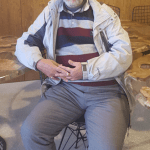A Closer Look at The World’s Largest Unaddressed Disability: Leveraging Inclusive Business to Eradicate Poor Vision
One extremely common disability is stopping children from getting an education and stopping adults from being able to support themselves and their families. It is undermining economic development, and entrenching gender inequality. What is this disability? Uncorrected poor vision – a problem that affects some 2.5 billion people. This means 1 in 3 people can’t see the world clearly, even though the solution could be as simple as access to a pair of glasses.
Around 90% of people with uncorrected poor vision live in developing countries where there is a severe lack of eye care professionals and optical outlets. However, vison care continues to rank low on the list of government development priorities – even though it can significantly affect one’s ability to learn and work, if left uncorrected. In fact, poor vision costs the global economy $227 billion in lost productivity annually: Imagine the difference this productivity could make in these developing countries.
Unfortunately this situation only looks to be getting worse. By 2050, it is estimated that half of the world’s population will be affected by myopia (nearsightedness). Yet despite the statistics on the impact this problem can have on individuals and countries as a whole, it has yet to garner the attention it deserves.
Setting our Sights on a Sustainable Infrastructure
Essilor, as the leading manufacturer of ophthalmic lenses and optical equipment, has always been on a mission to improve lives by improving sight. Our ambition is to eradicate poor vision by 2050. However we can’t do this alone. We collaborate closely with a wide range of partners, including other corporates, NGOs, local governments and local communities. Together we provide sustainable access to vision care for underserved populations through the development and deployment of inclusive business models that are scalable, adaptable and impactful.
For Essilor, “inclusive” business models mean commercially viable models that benefit low-income communities by including them in the value chain – on the demand side as customers, and on the supply side as entrepreneurs. One example of this is our Eye Mitra program in India, launched in 2013. “Eye Mitra,” which means friend of the eyes in Hindi, was created to increase awareness and access to vision care for underserved populations, as well as to improve local livelihoods.
With only one qualified optometrist for every 25,000 people, and some 550 million people suffering from uncorrected poor vision, India’s situation is similar to that of many developing countries. Existing eye care services are often in cities, and are not accessible for people living in rural or remote areas. To address this, the Eye Mitra program trains unemployed and underemployed youth in these rural areas to become micro-entrepreneurs, providing primary vision care and selling low-cost eyeglasses in their communities.
The Vision for Tomorrow
Inclusive business models like Eye Mitra help to address three problems common in developing countries: a lack of primary vision care professionals; a lack of access points for vision care; and youth unemployment in rural communities. The inclusive nature of these models allows for the development and training of a constant talent pool of vision care providers, building a sustainable infrastructure that brings greater access and affordability in vision care to underserved communities.
Today, Eye Mitra has become the world’s largest rural optical network. It’s active across 14 Indian states, increasing access to affordable vision care and giving young people the skills and qualifications to earn a livelihood locally – as well as empowering women to contribute socially and economically to their communities. An independent study by Dalberg Global Development Advisors concluded that if the Eye Mitra initiative were scaled up to all districts in India, it would represent a potential impact of US $487 million annually. The success of Eye Mitra in India also led to its expansion and adaptation into other markets, like Bangladesh, Kenya and Indonesia in 2018, and China in 2017.
Currently, the program includes 9,000 trained primary vision care providers, with the potential to serve over 200 million people across the world who are living at the “base of pyramid” – the largest but poorest socio-economic group, who live on less than $2.50 a day. Since 2013, it has equipped over 23 million people with corrective eyewear, and we hope to see this number grow to over 50 million by 2020, as we continue to scale up our efforts across the world.
A Brand New Point of View
Operating an inclusive business model at scale comes with its fair share of challenges. It is important for businesses to have the right mindset and look upon these challenges as opportunities to grow their business sustainably while also having social impact. At Essilor, when piloting a new inclusive business model, we always follow these principles:
- Understand that your consumers are different. There is no one-size-fits-all solution. Begin by exploring specific needs, challenges, and opportunities in a country, and build local capacity.
- Expectations do not always match reality on ground. Before scaling up, it is important to incubate different inclusive business approaches and test them via pilots.
- Have one common goal. It helps in driving innovation, and allows you to remain focused on your mission even as you continue to grow as a business.
- Listen to the feedback of partners and beneficiaries of your programs. It can inspire you to develop a catalog of innovation solutions.
The Eye Mitra program owes much of its success to these principles. We believe they can also be of use in other business approaches targeting low-income customers – not just in eye care or in India, but across sectors and around the world.
Jayanth Bhuvaraghan is Chief Mission Officer at Essilor International.
Image provided by author.
- Categories
- Health Care, Social Enterprise



